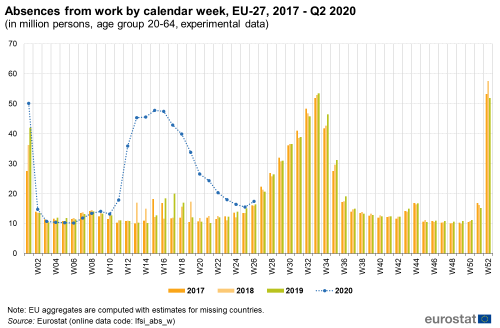Data extracted in October 2020
Planned article update: January 2021
Highlights
To respond to the need for a more thorough analysis of the labour market situation during the recent COVID-19 pandemic, Eurostat developed a new experimental indicator “Weekly absences from work”. This indicator focuses on employed persons who are temporarily absent from work in a reference week.
This article presents the main results from this new indicator and complements the article Absences from work - quarterly statistics. Both articles are part of the publication Labour market in the light of the COVID-19 pandemic.
The current version of the article focuses on the first half of 2020. In January 2021, the article will be reviewed and data on the third quarter will be added.
Weekly absences from work spiked in April 2020
Weekly absences from work in the EU usually peak in weeks 1, 33 and 52 of the year, corresponding to early January, mid-August and late December (Figure 1). However, from the second week of March 2020 (week 11, 2020) onwards, weekly absences sharply increased as a consequence of the first confinement measures against the spread of the COVID-19 pandemic taken by the governments. In detail, weekly absences steeply increased from 13.2 to 45.4 million from early to late March 2020 (from week 10 to week 13, 2020). The increase continued over and the first and the second week of April 2020 (week 14 and 15, 2020), when 45.6 and 47.8 million people, respectively, were absent from their jobs. For a benchmark, the number of people absent from work in the second week of April represents more than 90 % of the peaks in late December 2019 (week 52, 2019) and early January 2020 (week 1, 2020), where, respectively 51.9 and 50.2 million people were absent from work.
Figure 2 compares absences from work in the EU in the first 26 weeks of 2020 with the average of the corresponding weeks in the period 2015-2019. It is visible that the number of weekly absences in January, February and early March 2020 (weeks 1 to 10, 2020) was similar compared with the previous years. Even though the number of absences for week 1 2020 (30th of December 2019 - 5th of January 2020) was much higher than the average of previous years, it was still below the maximum recorded for this week in 2015 (week 1: 50.2 million in 2020, 54.2 million in 2015).

Source: Eurostat (lfsi_abs_w)
From the second week of March 2020 (week 11, 2020) absences from work increased substantially. In this week, the number of absent from work people was with 4.7 million more compared with the previous week (week 10, 2020) and with almost two thirds more (64.6 %) compared with the average number of absences for this week during the previous five years. This growth reached much more significant dimensions by the end of the month. When every week is compared with the previous one, it is visible that in weeks 12 and 13, corresponding to mid and late March 2020, absences went up with 18.1 and 9.5 million, respectively. In April 2020, the growth of absences continued, although slower compared to the previous weeks, with an increase of weekly absences of respectively 0.2 and 2.2 million for the first and the second week of the month (weeks 14 and 15, 2020). Nevertheless, in the second week of April 2020 (week 15, 2020), absences from work recorded its highest point for the first half of 2020, namely 47.8 million. For comparison, this was nearly three and a half times more than the average number of absences recorded for this week over the previous five years which was 13.9 million.
After mid-April 2020, absences from work took a downward path. However, their decrease was not as rapid as their increase. The reduction of weekly absences was with 4.3 million on average per week until mid-May 2020 (week 20, 2020) when they reached 26.5 million. Nevertheless, this was still more than twice as the average number recorded for the 20th week of the previous half-decade which was 11.6 million. The number of people absent from their jobs continued to decline and during the following five weeks. This time more moderate decline of 2.2 million on average per week took place and absences from work reached 15.5 million in mid-June 2020 (week 25, 2020), however, this number was still with 1.8 million more compared with the average number of absences for the 25th week during 2015-2019, and also with 2.3 million more compared with early March 2020 (week 10, 2020). In the last week of the first half of 2020, namely the end of June (week 26, 2020), the number of absent from work people increased again, this time with 1.9 million in comparison with the previous week, and reached 17.4 million. For reference, the average number of absences for the same week during the previous five years was 15.6 million.
All in all, looking at the first half of 2020, during all weeks after mid-February (week 8, 2020), absences from work exceeded their maximums recorded for the previous five years. This was most visible in the period from the mid-March 2020 (week 11, 2020) until the last week of April 2020 (week 18, 2020). During these weeks, absences from work were with at least 20 million more than the maximum number for the corresponding week during the past five years. Especially, in the beginning of April 2020 (week 14, 2020) when the number of absent from work people was with 30.7 million more than the maximum number of absences during the last five years recorded in week 14 in 2018 which had been namely 15.0 million.
Gender equilibrium among weekly absences in April 2020
In this section of the article is presented information on the ratio between men and women among people absent from work in the first 26 weeks of 2020 in the EU. For a benchmark, the average of this ratio for the last five years (2015-2019) is also included. All this is visually illustrated in Figure 3. Note that a ratio gravitating towards 100 % suggests gender equilibrium, whereas a ratio above this threshold implies that men are preponderated among absent from work people, and the opposite is suggested by ratios below 100 %.

Source: Eurostat (lfsi_abs_w)
Men to women ratio for the first week of 2020 was 107.0 %, slightly more than the average for the same week in 2015-2019 which was 106.7 %. In other words, male absences from work were with 7.0 % more than female’s in the first week of 2020 and, respectively, with 6.7 % more on average for the same week over 2015-2019. After this week, up to early March (week 10, 2020), men to women ratio went down, closely resembling the average of this ratio for the previous five years. More precisely, from 107.0 % in the first week of 2020, it dropped to 82.9 % in the second week of the year, hereafter it continued to gradually decline and reached it lowest point in early March 2020 (week 10, 2020), when men to women ratio accounted for 66.5 %, or men were with one third (33.5 %) less than women among the group of absent from work people.
From the second week of March (week 11, 2020), alongside with the outbreak of the COVID pandemic, men to women ratio started to increase steeply. The development of this ratio in March 2020 was the following, from 66.5 % at the beginning of the month (week 10, 2020) to 96.5 % by its end (week 13, 2020). In the first week of April 2020 (week 14, 2020), the number of men exceeded those of women among absent from work people. This is implied by men to women ratio for this week of the year amounting to 102.6 %. Indeed, during this week, marked with one of the greatest peaks of total absences of the year 2020 so far, the number of absent from work men was 23.1 million, whereas the corresponding number for women was 22.5 million. For comparison, the average number of absent form work men and women for week 14 during the previous five years was, respectively, 5.3 and 7.2 million, corresponding to an average men to women ratio of 73.6 %.
After its peak in early April (week 14, 2020), men to women ratio decreased to levels below 100 % and gradually, but rather tentatively, began to decline over the weeks up to the end of June 2020 (week 26, 2020) when reached 76.2 %. Nevertheless, for the whole period from week 11 to week 26 2020, men to women ratios were above the levels of its average over the previous five years. Most prominently, from mid-March and the whole April 2020 (weeks 12 to 17, 2020), when men to women ratios were with more than 20 p.p. higher than the average of this ratios for 2015-2019. The greatest difference could be observed for week 15, 98.9 % men to women ratio for this week in 2020 compared with 69.4 % on average for the same week over 2015-2019.
XXX
All EU Member States for which data are available experienced a rise in weekly absences from work towards the end of March 2020. Even if this rise did not start from the same week for all countries, weekly absences started to increase steeply from the second or third week of March (weeks 11 or 12, 2020) in the majority of countries. A reproduction of Figure 2 at country level demonstrates this finding, and the illustration for Slovakia and Spain can be found in Figures 5 and 6.
In Slovakia (Figure 5), absences from work during the first 10 weeks of 2020 followed the same pattern as for the previous five years, with the exception of the beginning of January and late February (weeks 1 and 8, 2020). From the second week of March (week 11, 2020) onwards, the number of absences began to increase significantly, both in comparison with the preceding weeks since the beginning of 2020 and to the average of the corresponding weeks in 2015-2019. At the end of March 2020 (week 13, 2020), 1.0 million people were absent from work in Slovakia. Compared with the beginning of March (week 10, 2020), this number rose by 0.9 million. By contrast, the average number of people absent from work in Slovakia in week 13 of the year for the period 2015-2019 had been 91 300.
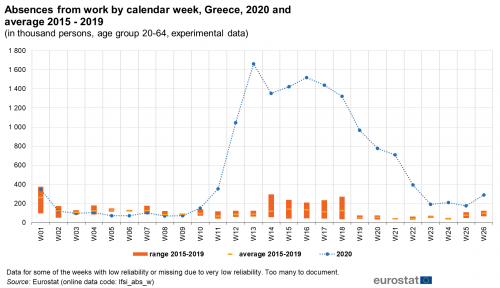
Source: Eurostat (lfsi_abs_w)
In Spain (Figure 6), the weekly pattern of absences in 2020 was similar to that of the last five years until the second week of March (week 11, 2020), although weekly absences were higher in 2020. From mid-March (week 12, 2020), absences began to substantially increase. Indeed, while 1.1 million people were absent from work in Spain in the second week of March (week 11, 2020), this number was four times higher in the following week and reached 4.5 million. And in the last week of the month (week 13, 2020), absences accounted for 6.0 million people. By comparison, the average of absences for the same period (week 13) for the last five years accounted for 1.2 million.
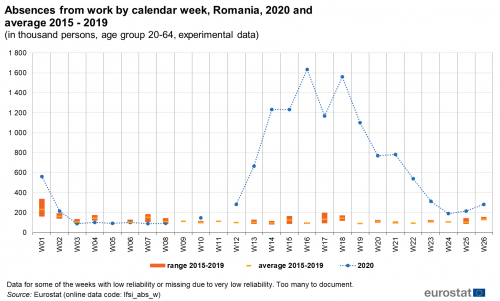
Source: Eurostat (lfsi_abs_w)
Two Member States, namely, the Netherlands and Italy, differ substantially from the others in terms of starting point of the increase of absences. In the Netherlands (Figure 7), the number of people absent from work started to increase only in the last week of March (week 13, 2020), so quite later than for the other Member States. Absences from work in the Netherlands since the beginning of 2020 closely followed the same pattern as the last five years, with the exception of the second week of January (week 2, 2020). Nevertheless, at the end of March (week 13, 2020) weekly absences from work increased by 65.3 % compared with the previous week and doubled in size in comparison with the average for the same period in the previous years. The number of Dutch people absent from work reached 1.1 million in the last week of March 2020, which corresponds to 0.6 million more than the average of week 13 computed over the five preceding years.
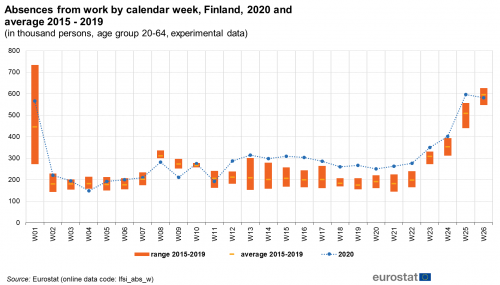
Source: Eurostat (lfsi_abs_w)
By contrast, Italy is the country where the increase in the number of people absent from work began to increase exponentially already at the end of February 2020 (Figure 8). While 0.9 million Italian people were away from their jobs mid-February (week 8, 2020), this number almost doubled in the following week, reaching 1.6 million, and continued to increase until the end of March (week 13, 2020). In that last week, 8.2 million people were absent from work in Italy, ten times more than the average of the absences for week 13 in the last five years.
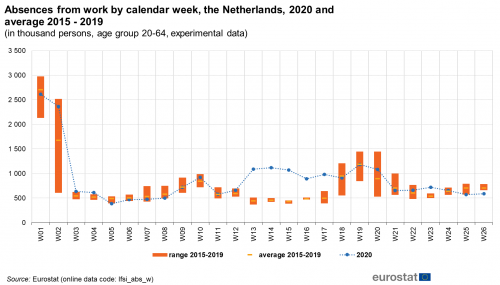
Source: Eurostat (lfsi_abs_w)
Similar graphs for all other countries with data available for more than 50% of the weeks can be found ![]() here.
here.
Although all countries experienced an increase in absences from work in March 2020, the increase was sharper for some than for the others. If comparing the average number of all people who were absent from work in weeks 10 to 13 during the period 2015-2019 with the absences for the same weeks in 2020, the largest increases can be found in Greece and Cyprus; from 0.3 to 3.2 million absences in Greece, and from 0.04 to 0.3 million absences in Cyprus. On the other hand, the smallest increase can be observed in Finland (from 0.9 to 1.1 million), followed by the Netherlands (from 2.5 to 3.2 million).
Source data for tables and graphs
Data sources
All figures in this article are derived from the European labour force survey (EU-LFS).
Source: The European Union labour force survey (EU-LFS) is the largest European household sample survey providing mostly quarterly and annual results on labour participation of people aged 15 and over as well as on persons outside the labour force. It covers residents in private households. Conscripts in military or community service are not included in the results. The EU-LFS is based on the same target populations and uses the same definitions in all countries, which means that the results are comparable between countries.
European aggregates: EU refers to the sum of EU-27 Member States. If data are unavailable for a country, the calculation of the corresponding aggregates is computed with estimates. Such cases are indicated.
Country note: Due to technical issues with the introduction of the new German system of integrated household surveys, including the Labour Force Survey (LFS), the figures for Germany for the first and second quarter of 2020 are not direct estimates from LFS microdata, but based on a larger sample including additional data from other integrated household surveys. For more information, see here. The figures for Germany are included in the EU aggregates; however, they are not available separately.
The notion of temporary absence from work refers to situations in which a period of work is interrupted by a period of absence. This implies that persons are generally to be considered as having been temporarily absent from work and therefore employed if they had already worked at their current activity and were expected to return to their work after the period of absence. Persons without work who had made arrangements to take up paid employment or to engage in some self-employment activity at a date subsequent to the reference period, but who had not yet started work, are not to be considered as temporarily absent from work.
For more information on absences from work, please consult pages 22 to 28 from the EU Labour Force Survey Explanatory Notes
Context
The COVID-19 virus hit Europe in January and February 2020, with the first cases confirmed in Spain, France and Italy. COVID-19 infections have now been diagnosed in all European Union (EU) Member States.
To fight the pandemic, EU Member States have taken a wide variety of measures.
From the second week of March, most countries closed retail shops apart from supermarkets, pharmacies and banks. Bars, restaurants and hotels have also been closed. In Italy and Spain, non-essential production was stopped and several countries imposed regional or even national lock-down measures which further stifled the economic activities in many areas.
In addition, schools were closed, public events were cancelled and private gatherings (with numbers of persons varying from 2 to 50) were banned in most Member States.
The large majority of the prevention measures were taken during mid-March 2020 and most of the prevention measures and restrictions were kept for the whole of April and May 2020.
The first quarter 2020 is consequently the first quarter in which the labour market across the EU has been affected by COVID-19 measures taken by the Member States.
Employment and unemployment as defined by the ILO concept are, in this particular situation, not sufficient to describe the developments taking place in the labour market. In this first phase of the crisis, active measures to contain employment losses led to absences from work rather than dismissals, and individuals could not search for work or were not available due to the containment measures, thus not counting as unemployed.
Explore further
Other articles
Database
Thematic section
Selected datasets
</methodology>

